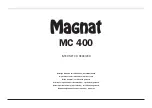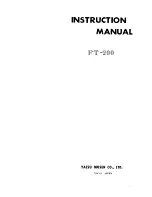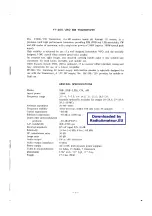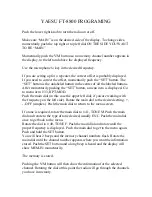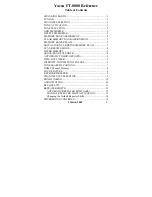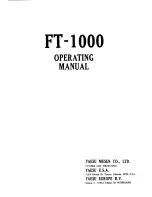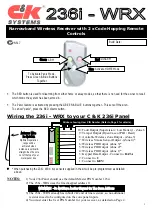
35
EN
Ambience effects
Dolby Pro Logic
II
x and Dolby Pro Logic
II
Dolby Pro Logic
II
was designed specifically to provide a new
sense of spatiality, directionality and articulation of sounds from
Dolby Surround encoded sources (such as video and Laserdisc
software marked
). This is achieved with an intelli-
gent, built-in feedback logic design, a matrix surround decoding
and the decoding of stereo, full bandwidth surround outputs.
Dolby Pro Logic
II
x enhanced Dolby Pro Logic
II
’s features.
It creates 6.1 channel and 7.1 channel surround sound from stereo
or 5.1 channel signals. This feature provides you an astonishing
ambience effect which makes you feel you are surrounded by
natural sound. Especially 7.1 channel surround sound can produce
real back sound from Surround Back speakers.
The Pro Logic
II
x modes programmed into this model are “Movie”,
“Music” and “Game”. The Pro Logic
II
modes programmed into
this model are “Movie”, “Music”, “Game” and “Pro Logic”. The
“Movie” mode has preset characteristics to produce a calibrated,
high-level surround sound playback while the “Music” mode has
user-adjustable characteristics to offer the three optional controls,
like “Dimension”, “Center Width” and “Panorama” modes to
allow optimization of the soundfields as desired. The “Dimen-
sion” control allows the user to gradually adjust the soundfield
either towards the front or towards the rear; the “Center Width”
control allows various adjustment of the left-center-right speak-
ers’ balance; the “Panorama” mode extends the front stereo
image to include the surround speakers for an exciting “wrap-
around” effect with side wall imaging.
The “Game” mode provides surrounded and exciting sound when
you enjoy game or TV. Especially in Pro Logic
II
x “Game” mode,
base sound not only from Front and Center but also from Surround
channel is added to Subwoofer. This provides ever more dynamic
surround effects.
DTS
The DTS multi-channel audio format is available on CD, LD and
DVD software. DTS is a strictly digital format and cannot be
decoded inside most CD, LD or DVD players. For this reason, if you
attempt to listen to DTS encoded software through the analog
output of your new CD, LD or DVD player, you will experience
digital noise in most cases. This noise can be quite loud if the
analog output is connected directly to a high power amplification
system. Proper measures for playing the digital output as de-
scribed below should be taken to avoid this situation. To enjoy DTS
Digital Surround playback, an external 5.1 channel DTS Digital
Surround decoder system or an amplifier with a built-in DTS Digital
Surround decoder must be connected to the digital output (S/P
DIF, AES/EBU or TosLink) of a CD, LD or DVD player.
All models are incorporated with the DTS decoder.
DTS-ES
DTS-ES (Digital Theater System-Extended Surround) presents 6.1
channels surround system with additional Surround Back channel
which evolved from the conventional 5.1 channels surround
system. DTS-ES format that was recorded in DVD, CD or LD
comprises of two modes. DTS-ES Discrete 6.1 produces the
discrete surround back which is completely independent and DTS-
ES Matrix 6.1 produces the surround back which synthesised
within the left and right surround channels using matrix technol-
ogy. DTS-ES has perfect compatibility with the conventional 5.1
channels surround system. 6.1 channels surround with an addi-
tional surround back presents a more natural presence and sur-
round effects by increasing the impression of the sound image
from back. Programs which are recorded using DTS-ES technol-
ogy consist of information flags which will be able to control the
Discrete and Matrix mode. Thus, it can automatically select the
best matched mode.
Neo:6
Neo:6 is a new technology which was developed by DTS. It can
produce high grade 6 channels surround with an astonishing
fidelity from 2 channels content. Neo:6 has 2 modes, “Cinema”
mode is for movie playback and “Music” mode is for music
playback.
DTS 96/24
DTS 96/24 made it possible to achieve a wide frequency range of
over 40 kHz by increasing the sampling frequency to 96 or 88.2
kHz. Moreover, DTS 96/24’s ability of 24 bit resolution offers the
same frequency band and dynamic range as 96 kHz/24 bit PCM.
DTS 96/24 is, as with conventional DTS Surround, compatible with
multi-channels. Therefore, sources recorded using DTS 96/24
technologies can be played in high sampling frequency, multi-
channel audio with ordinary DVDs and CDs.
DTS has a “.1” or “LFE” channel.
The indication “
LFE
” appears in the display when a signal is being
input for this channel.
Dolby Virtual Speaker
The Dolby Virtual Speaker features a virtual surround sound field.
This implements an effect as if there are multiple speakers in the
listening room.
Dolby Headphone
When headphones are used in music listening, the audio of the left
(or right) channel reaches only the left (or right) ear so the listener
cannot feel the presence of acoustic images on the front.
The Dolby Headphone simulates a virtual room and include its
acoustic characteristics in the left and right headphone signals. As
a result, the listener can hear the same components as in speaker
listening through the left and right years and therefore feel as if the
sound source is located on the front of the listener.
Because of the same processing in "Pro Logic
II
Movie mode with
Dolby Headphone" and "Pro Logic
II
Game mode with Dolby
Headphone", their respective effectiveness is the same.
Note
LFE
= Low Frequency Effects. This channel delivers separate
non-directional bass signals to the subwoofer for more dynamic
deep bass sound effects.
DSP mode
The DSP mode lets you add the atmosphere of a live concert or hall
to almost any type of program source. The way a sound is heard in an
actual environment depends on a variety of different factors. One of
the most important is reverberation (the act of decaying elements of
sound echoing in various places).
The DSP modes produce the feeling of presence by using the DSP to
create reverberation, without spoiling the sound quality of the original
signal. These modes are particularly effective when used with stereo
program sources, like CD, television, and FM radio. You might enjoy
trying the Arena, Jazz Club, Theater, Stadium or Disco mode the next
time you watch a concert or sporting event!
Dolby Digital
The Dolby Digital surround format lets you enjoy up to 5.1
channels of digital surround sound from Dolby Digital program
sources (such as Laserdisc or DVD software marked
).
Compared with previous Dolby surround, Dolby Digital provides
even better sound quality, greater spatial accuracy, and improved
dynamic range.
Dolby Digital EX
Dolby Digital EX is an extension of Dolby Digital technology, Dolby
Digital EX creates six full-bandwidth output channels from 6.1-
channel sources. This is done using a matrix decoder that derives
three surround channels from the two in the original recording.
This is achieved by using three different surround signals, sur-
round left, surround right, and surround back, each driving its own
array of speakers. Think of it as adding a center channel for the rear
speakers, which give more diffuse and natural surround effect,
even if you wanted the ability to completely encircle the audience
with sound, positioning sound effects exactly where they would
be heard in real life. For best results, Dolby Digital EX should be
used with movie soundtracks recorded with Dolby Digital Sur-
round EX which contain a digital flag that will automatically
activate this feature. However, for titles released prior to late
2001, this feature has to be activated manually.
Although Dolby Digital soundtracks incorporate a separate low
frequency channel, connecting a subwoofer will also improve
deep bass performance in the other surround modes.
The indication “
LFE
” appears in the display when a signal is being
input for this channel.
*5561/34-42/EN
05.7.18, 2:34 PM
35































